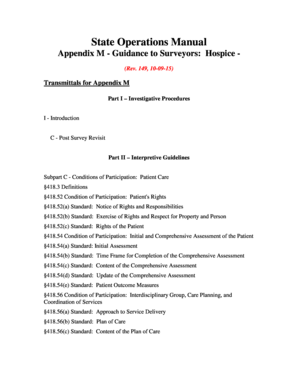
The information is not new, but represents revised guidance that was contained in a number of previously issued CMS S&C letters.
Cms Guidance To Surveyors Manual For Long
&0183 &32 Description: Survey protocols and Interpretive Guidelines are established in the State Operations Manual for Long Term Care Facilities to provide guidance to personnel conducting surveys they serve to clarify and/or explain the intent of the regulations and all surveyors are required to use them in assessing compliance with Federal requirements.CMS Updates State Operations Manual Guidance to SurveyorsThe Quality, Safety and Oversight (QSO) Memorandum includes draft updates to the CMS State Operations Manual that will guide survey and certification reviews. CMS has issued the guidance in draft and is soliciting comments from stakeholders by July 2, 2019.CMS Updates State Operations Manual Guidance to Surveyors. CMS issued Transmittal 127, which is a revision to Appendix PP, Guidance to Surveyors, of the State Operations Manual (SOM).The information is not new, but represents revised guidance that was contained in a number of previously issued CMS S&C letters.While many of the F-Tags contain only minor revisions, particular note should be.
Moreover, signaling that CMS recognizes the need for real, substantive changes to its current hospital co-location guidance, it invited the public to comment on the Memo, a rare move for guidance documents of this kind. The amendments would allow hospitals and providers to share certain non-clinical space, staff, and services (subject to restrictions). Earlier this year, the Centers for Medicare & Medicaid Services (CMS) released a proposed survey memo (Memo), which, if adopted, would expand the ability of Medicare-enrolled hospitals to co-locate with other healthcare entities.Specifically, the Memo would amend the CMS State Operations Manual Appendix A, which provides interpretive guidelines for contractors who certify hospital compliance with the Medicare conditions of participation (CoPs). The revisions in this F-Tag are substantial and address issues related to behavior and the care of residents with dementia including cause identification of the behavior and care planning, and the development of individualized approaches to address the behavior. Following a recently completed pilot project, CMS indicated that it intends to conduct a number of dementia focused surveys that will look at how facilities train staff and care for residents with dementia.
Finally, ASCs are increasingly sharing space with other types of providers, such as Office Based Labs. Moreover, two or more ASCs may co-locate in the same clinical space when such space is used exclusively by only one ASC at a time. For example, hospitals may be permitted to co-locate with other hospitals under the “hospital within a hospital” model (42 CFR 412.22(e)). Current CMS Guidance Regarding Co-Location ArrangementsHistorically, CMS has permitted co-location between Medicare-enrolled providers under limited circumstances.
Proposed ChangesUnder CMS’ proposed guidance in the Memo, CMS would provide greater certainty and flexibility to Medicare-enrolled hospitals in how they structure co-location arrangements. In the Memo, CMS appears to agree, at least in part. Those that have not abandoned co-location entirely have ensured that their operations were indeed completely separate from the other providers, including providing completely separate entrances, waiting areas, restrooms and other “non-clinical” spaces.Providers have routinely expressed, however, that co-location arrangements could be significantly expanded without negatively impacting patient care. And, because the penalty for running afoul of CMS’ guidance is so high (up to and including Medicare disenrollment of the hospital), many hospitals have abandoned their co-location arrangements, foregoing the substantial financial benefits associated with renting underutilized space or otherwise providing their patients with increased access to more flexible types of care.


Clarify precisely the types of staff permitted to “float” between entities (noting that the roles comprising a “medical staff” may vary, depending on the entity) and Provide exceptions to permit patients to travel under supervision through the clinical space of the co-located entity, if the such travel would assist in providing better patient care Clarify important definitions (such as the term “healthcare entity,” “distinct space” and “duty hours”) to prevent confusion While he did not go so far as to request that CMS permit sharing of clinical space under certain circumstances, he did request that CMS to: Among numerous other submissions from the public, on June 26, 2019, Senator Grassley published a letter detailing his office’s requests for clarification in the guidance.
The ability to share staff, especially when additional full-time employees are not necessary for one co-located provider, can provide benefits of convenience, better patient care and flexibility.We hope on behalf of our provider clients that CMS’ openness to the benefits of co-location and space sharing arrangements may result in additional flexibility in the future to benefit patients and providers alike. Hospitals may benefit from sharing non-clinical space and services with separate providers, especially in high-cost real estate markets.


 0 kommentar(er)
0 kommentar(er)
